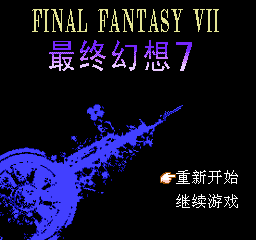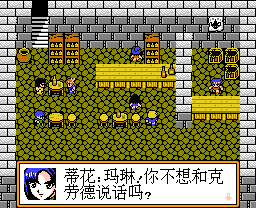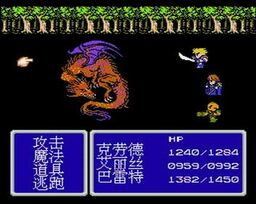The wiki is lacking in content. You can help by creating a new article. See the to do list for more ways you can help.
New user registration has been restored. Thank you for your patience.
Welcome Indie Wiki Jammers! Check out here for info on the jam
Final Fantasy VII (Famicom bootleg)

Final Fantasy VII (Chinese: 最终幻想7, Zuì Zhōng Huànxiǎng Qī) is an unlicensed demake of Final Fantasy VII for the Famicom. The game was developed by the Chinese company Shenzhen Nanjing Technology and was published in 2005, specifically for the Subor Famiclone. Final Fantasy VII's cartridge is structured differently than those of traditional Famicom games. The game is called Final Fantasy VII: Advent Children on the box and manual despite having no relation to the film.
Several gameplay elements are retained from the original game, such as a three-member party. The items, spells and equipment available are based upon those in the original game, and the original story remains accurately reproduced. On the other hand, a lot of the original gameplay was removed, including Summons, Limit Breaks, the optional characters Yuffie Kisaragi and Vincent Valentine, and nearly all of the sidequests. There are only six healing items and Materia is severely limited. Cid's airship was removed, so areas that are only accessible via airship are gone. Mt. Nibel and Fort Condor were also removed. The game's battle system is very difficult, as leveling and Materia growth have been made slower. Unlike the retail version, the final battle takes place after completing North Cave.
Gameplay[edit]

Most of the game occurs within Midgar for the first act and eventually expands to towns, dungeons, caves, and similar areas. Starting with the second act, the characters can freely explore the world map unless restricted by geographical obstacles, such as water or mountains. The characters can ride chocobos or various vehicles to overcome these obstacles. The party cannot breed chocobos like in the original game. As is typical for Final Fantasy games, several areas, including the world map are often interrupted by enemy encounters. The encounters are a lot more common in the Famicom version than in the original version.

Whenever an enemy is encountered, the map changes to the battle screen. The enemy is on the left side of the screen, and the party are on the right side. Each battle is turn-based similar to that featured in Final Fantasy III. All characters can physically attack the enemy, use spells from equipped materia, or use an item in one turn. The battle ends when the characters either defeat all enemies or flee from the battle, making the game return to the area map. The game itself ends if all party members are defeated, returning the player to the title screen. If one of the party members successfully flees, the battle also ends. There is a single save slot that the player can save their game progress to at any time except when in battle.
A character's performance in battle is determined by numerical values for categories such as speed, strength, and magical power. These statistics are driven by experience; the characters are awarded experience points for winning battles, which accumulate until the character levels up. When they level up, their statistics are permanently increased and can also be amplified by the equipment they are wearing. Winning battles may reward gil and items to the party.
Each character brings one materia into the party when they join, carrying one spell that can be used in combat. Materia have a limited number of uses before they must be recharged at one of the game's magic shops. Like party members, materia gain experience when used, and can be leveled up to a maximum level of nine. Characters can swap materia among themselves, with unequipped materia being used mid-battle for such things as healing party members, compensating for the limited amount of healing items.
Weapons follow the same principle as materia in terms of attack power, gaining experience and levelling up. Unlike materia, they cannot be swapped or replaced, and have unlimited usage. In addition to weapons, each has four types of armor that can be equipped for defense, which can be purchased at armor shops or found in chests scattered throughout the game. Armor directly affects the vitality statistic, which will in turn affect the amount of health gained when leveling up. Curative items are also available in-game, which can be purchased at designated shops or found in chests. These items can be used in or out of combat to restore health (HP), materia usage (CP), or revive fallen party members.
Development[edit]
Special compensation was made for some of the in-battle sprites such as Cloud Strife's, combining two 16x24 pixel sprites side by side instead of the usual single sprite to account for weapons such as Cloud's sword or Barret's gun. While most Japanese games use only 8x8-pixel hiragana or katakana fonts, and most Chinese games use 4-color 16x16-pixel tiles stored in dedicated CHR ROM pages, this game uses its own several-hundred 16x16-pixel monochrome font instead. The script itself is strewn in chunks across the code; at the beginning of each piece of text for dialog boxes is a three digit number preceded by an @ symbol, signifying which character portrait to display.
The circuit board layout is unique compared to most Famicom games, using a single 2MB PRG ROM chips. A RAM chip is used instead of a ROM for the character graphics data, similar to the UN-ROM method used in some Nintendo games. As a result, the data is strewn across the PRG ROM in various banks. The cartridge features one 8-kilobyte battery-backed RAM chip, used for the game's single save slot.
Many of the game's graphics are borrowed from other games, mostly other Final Fantasy titles and including Super NES graphics converted to four-color palettes used by the Famicom's hardware. One example is Cloud's sprite, which is the Fighter sprite from Final Fantasy but with yellow hair. Much of the game's music is borrowed from other games as well, in many cases shortened significantly to a few repeating notes. A lot of the soundtrack is taken from Final Fantasy II and Final Fantasy III. The victory theme is an 8-bit version of the original game's theme.
Reception[edit]
The game's receptions were mixed, cited as an impressive achievement but at the same time criticized for the difficulty and choice of a target console.
While the game has received praise for covering the entire story within the game, it has been described as extremely difficult, with an inconsistent battle rate and fights that take a long time to complete. Its limited healing options and slow growth rate for abilities and weapons compound this, with one reviewer recommending "play it — but cheat". Despite these issues, interest has been shown regarding the release of a patch to translate the game into English. Final Fantasy VII has additionally gained mention on several major gaming websites, including Gameworld Network, and Japan-based Gpara.com.
The game has received praise from various sources. Journalist Derrick Sobodash stated that while the game would not be an entirely new experience for those that played the original Final Fantasy VII, he added that "...this title can hold its own against the other NES Final Fantasy games", further calling the effort "surprisingly professional". Kotaku editor Luke Plunkett cited the Famicom game as "...an achievement I have no hesitation in labeling Herculean", further calling it "...a triumph of the human spirit". Boing Boing Gadgets and Wired News writer Joel Johnson described the game as "more than just a knock-off — it's an act of true skill and commitment by an unknown team of Chinese coders". GamePro named it one of the thirteen best fan-made video game remakes, placing first on their list and described as "the video game equivalent of the Human Genome Project", despite its flaws.
Square Enix response when given an inquiry was resoundingly negative, stating that their policy is to "decline any use of our copyrights. We currently are not granting permission to any one except our own business partners" and following with a citation from their privacy policy, which states "Any other use of materials of our games...without the prior written permission of SQUARE ENIX is strictly prohibited. No materials of our games may be used on any other product, published, or otherwise performed in public."[1]